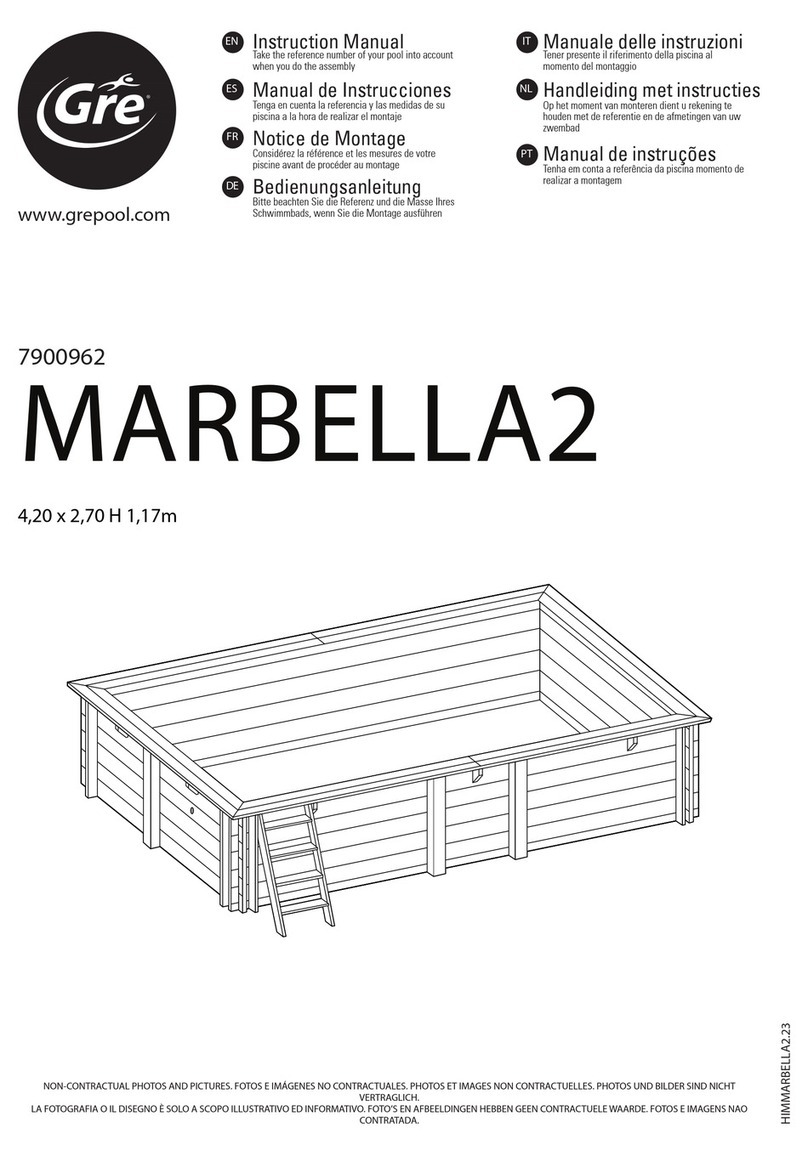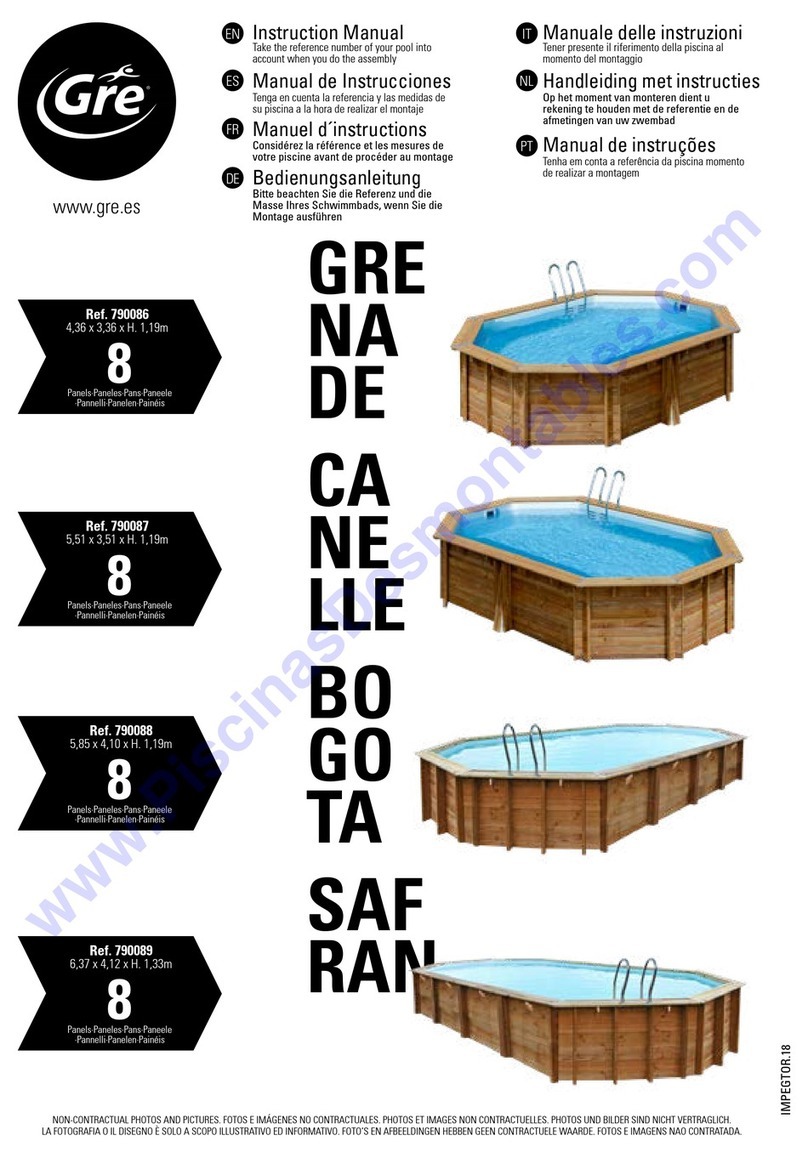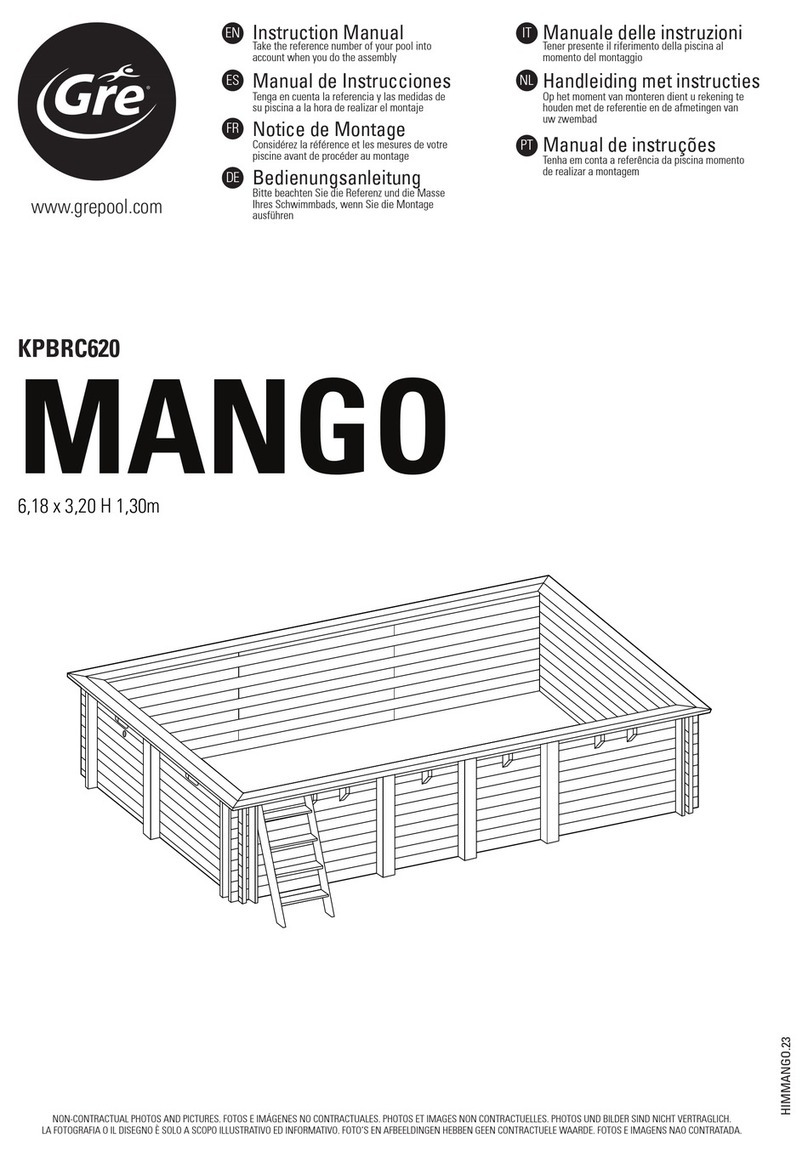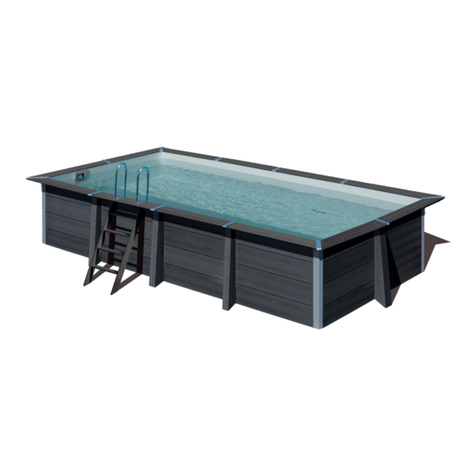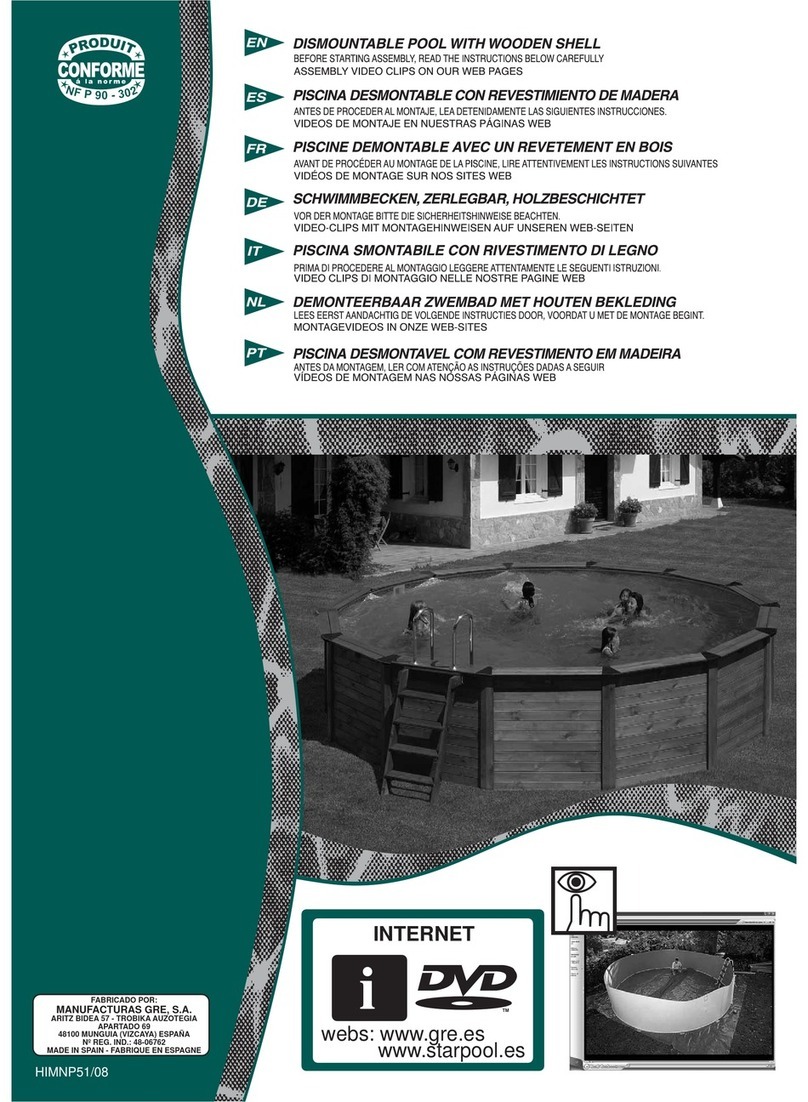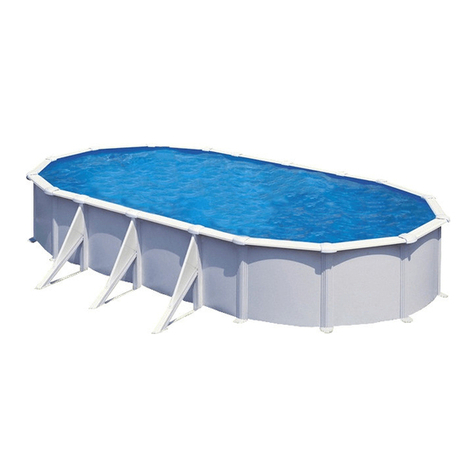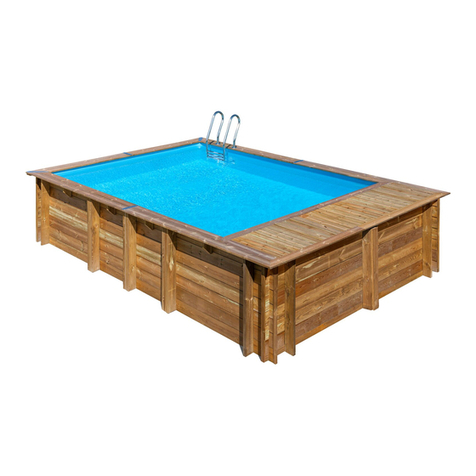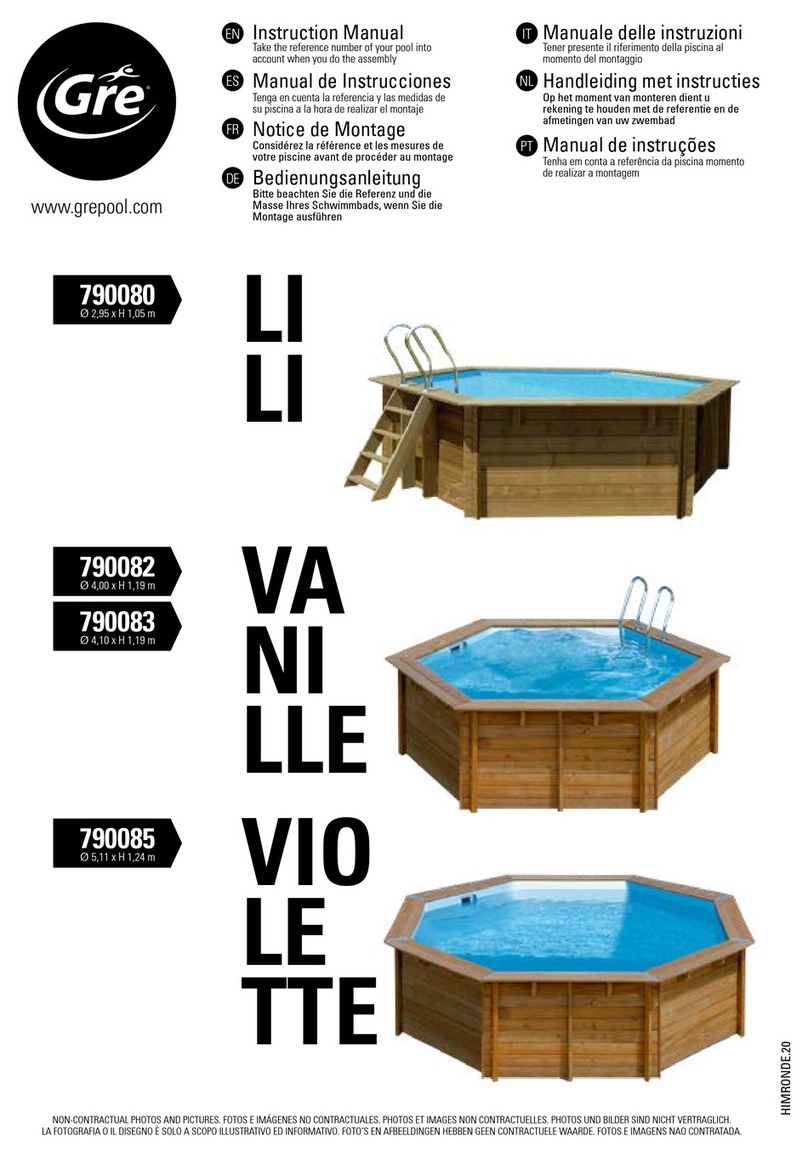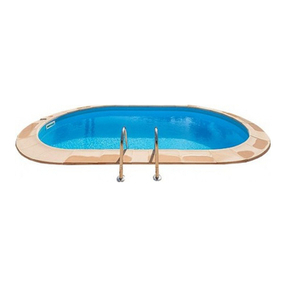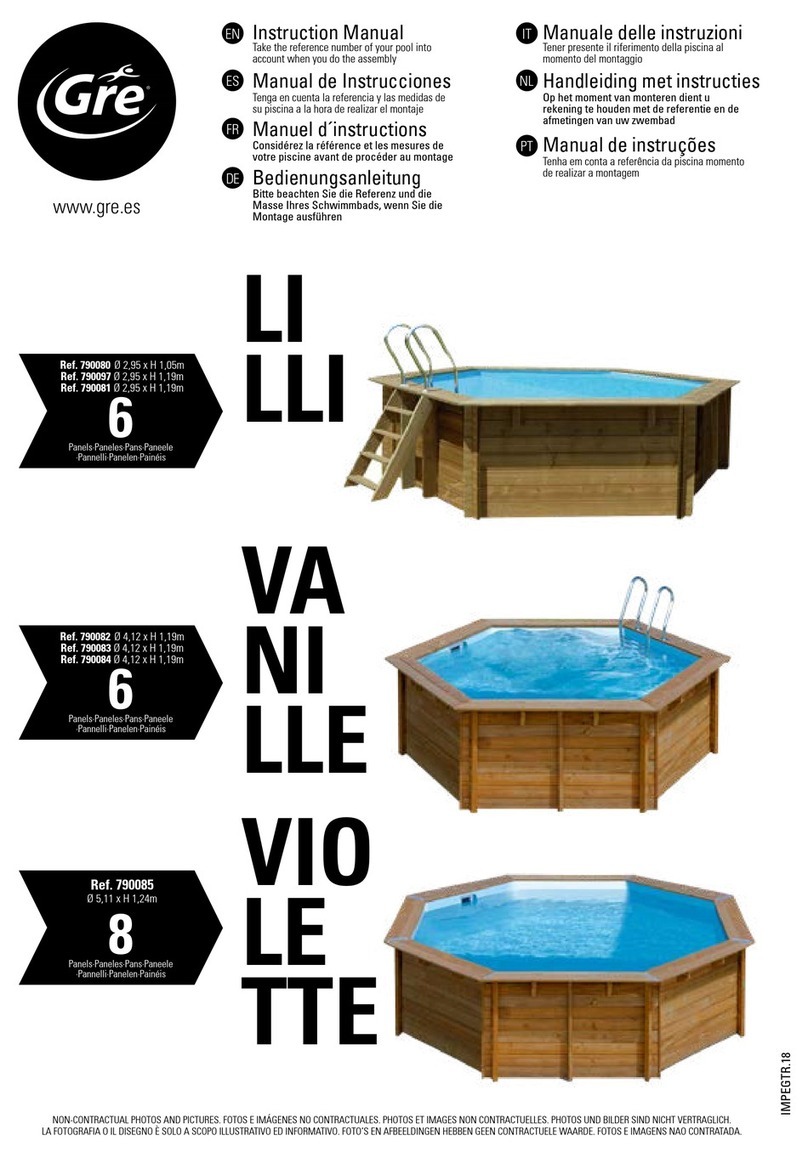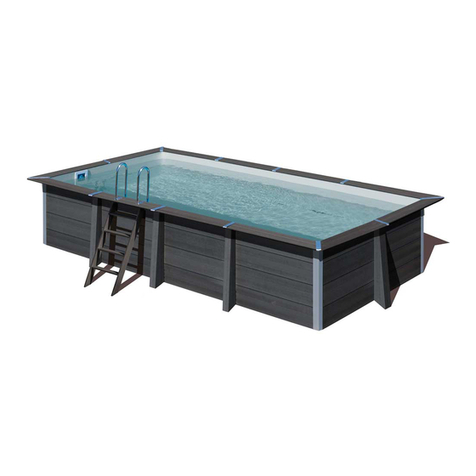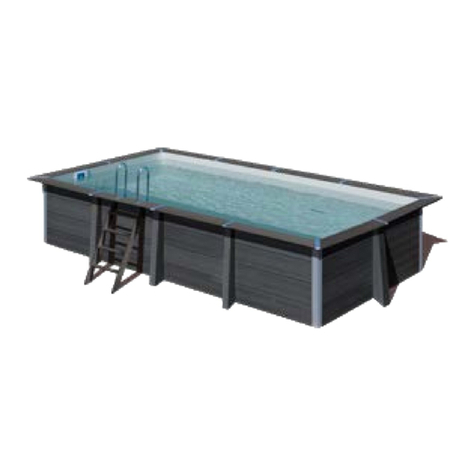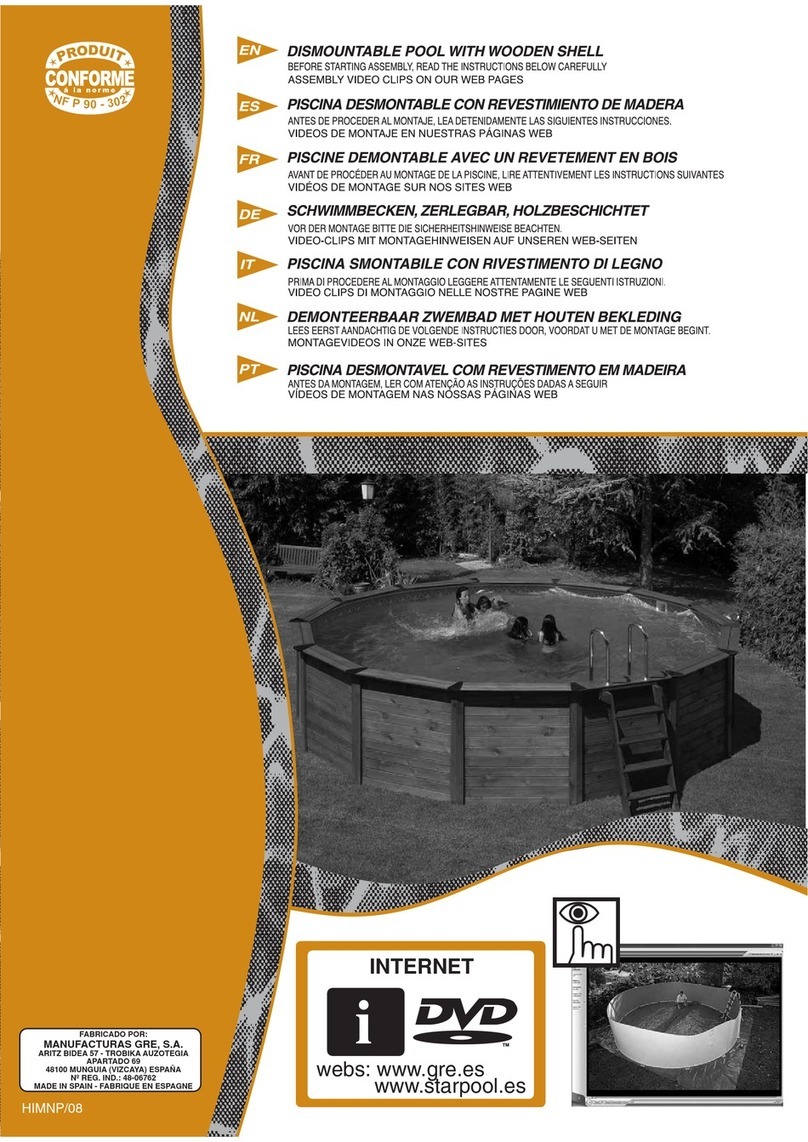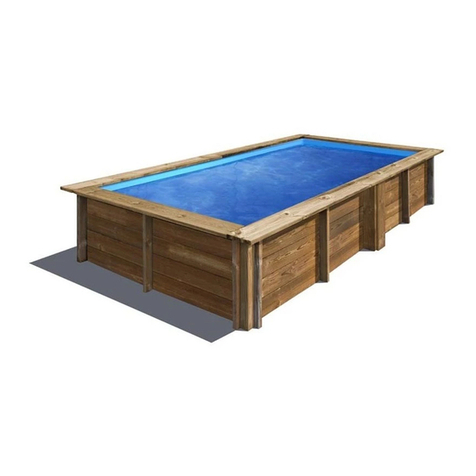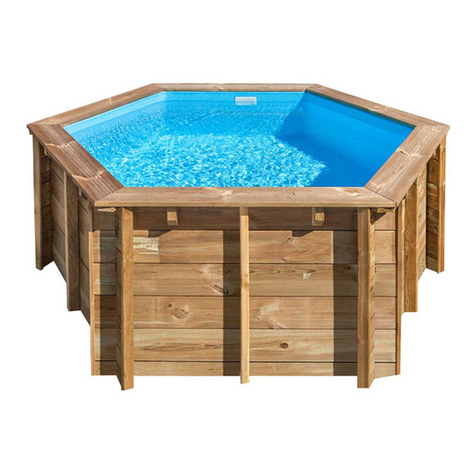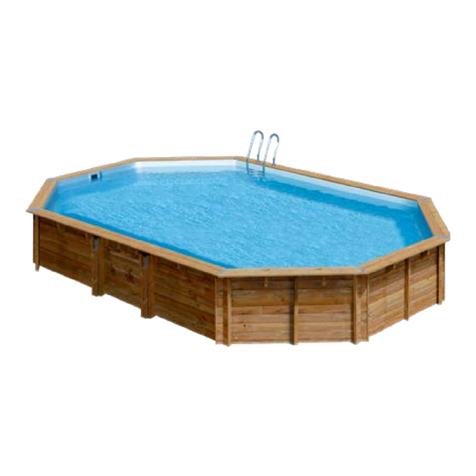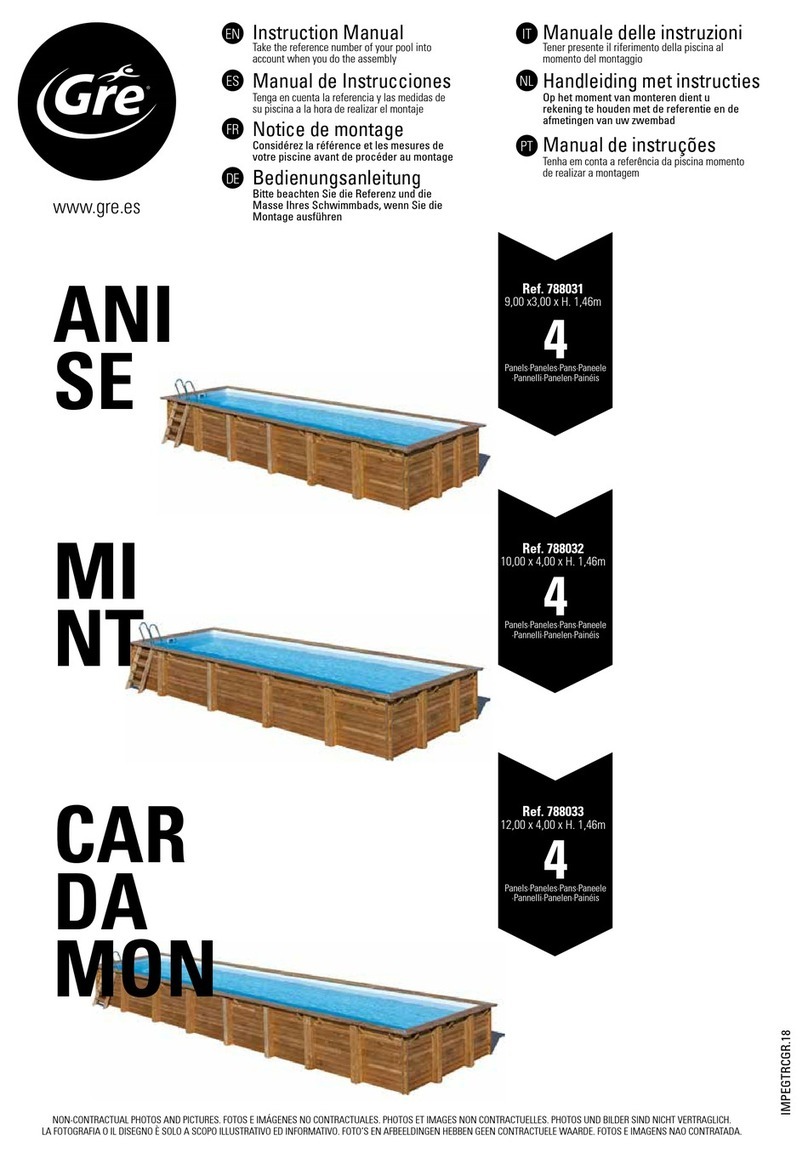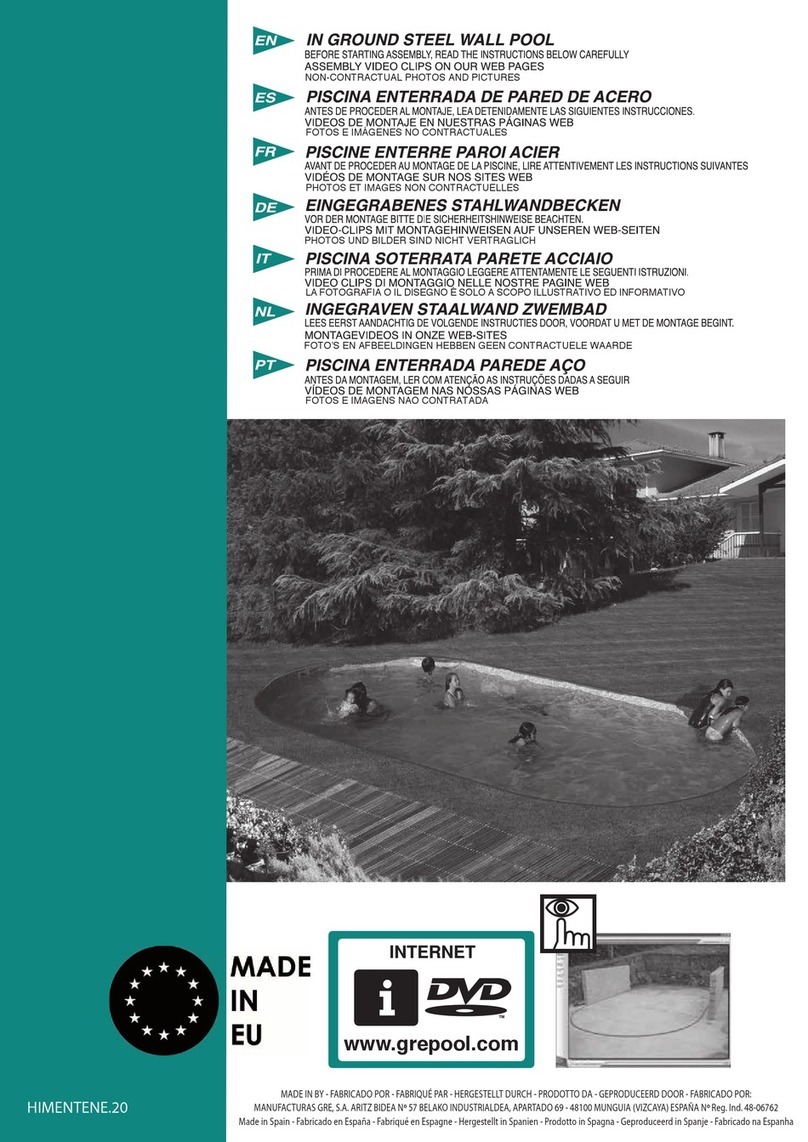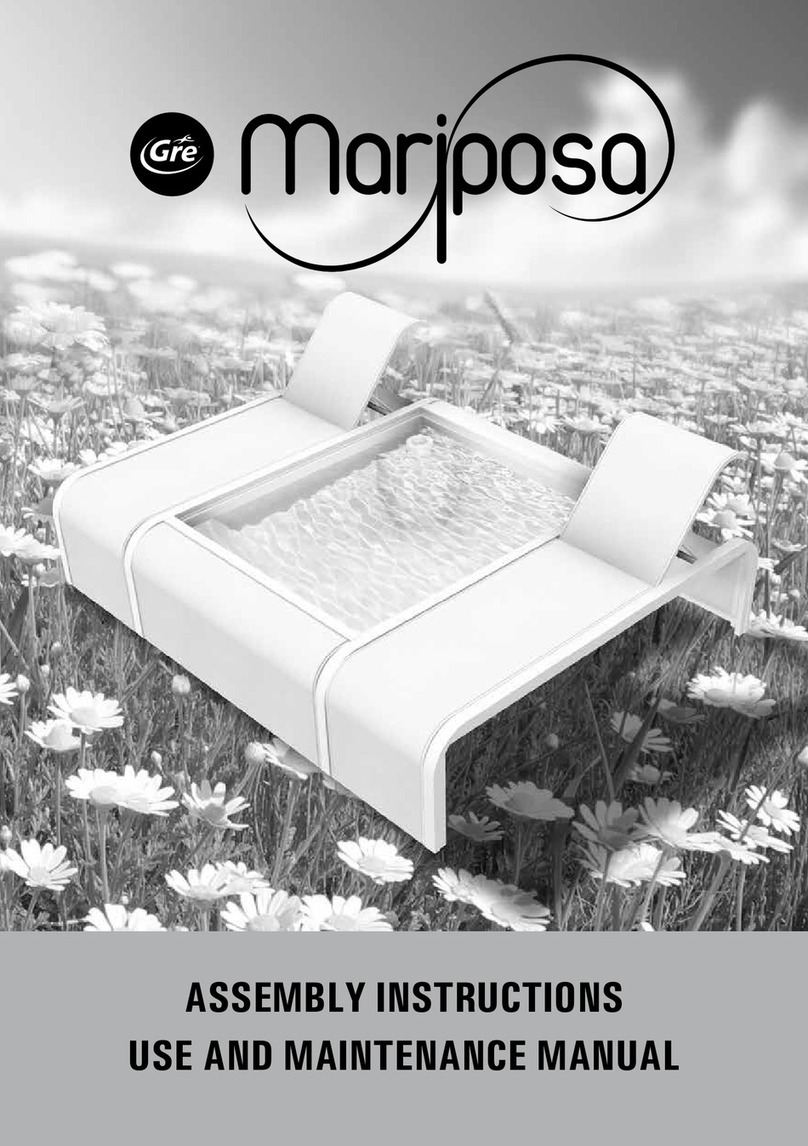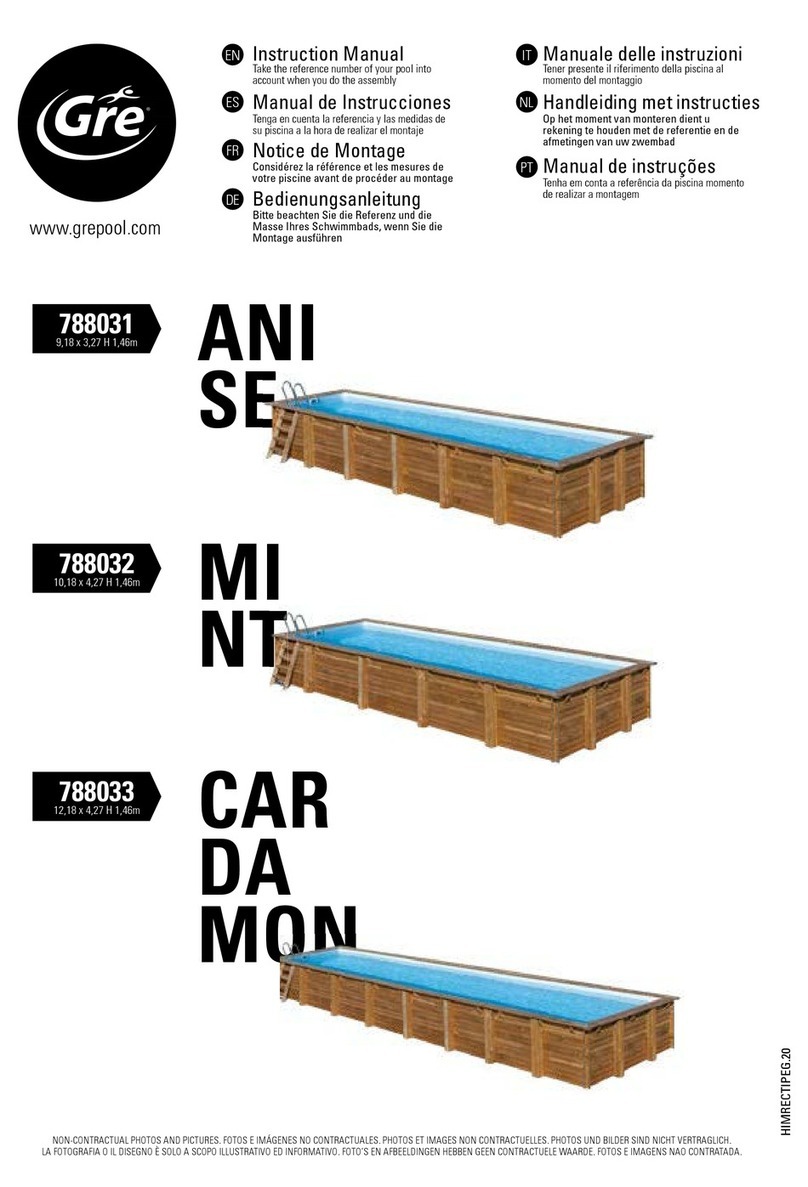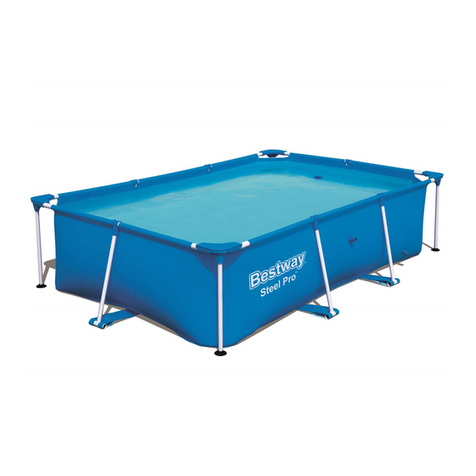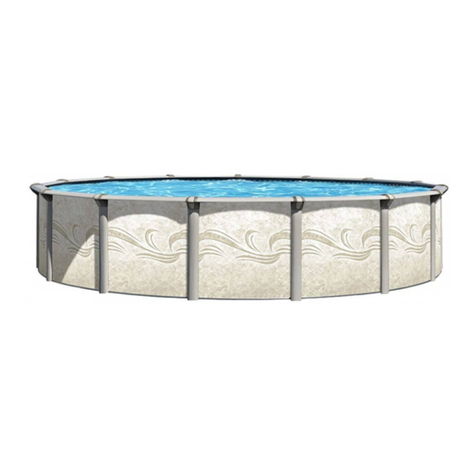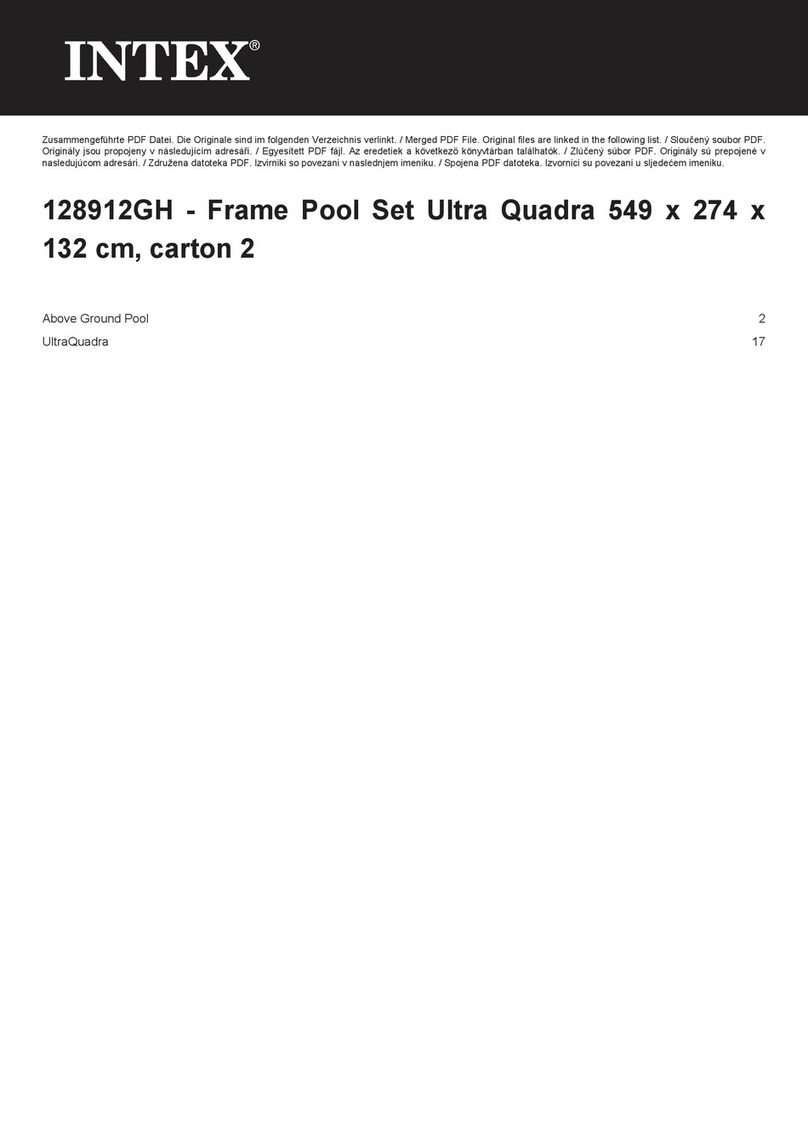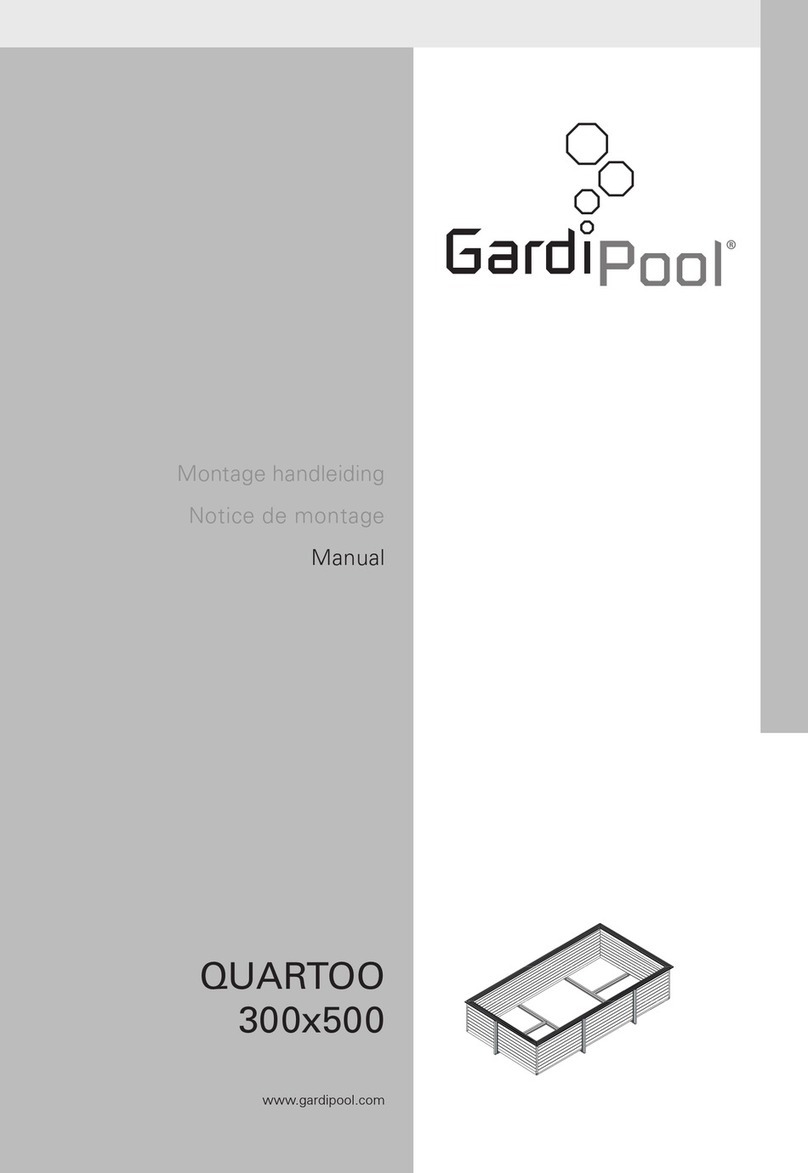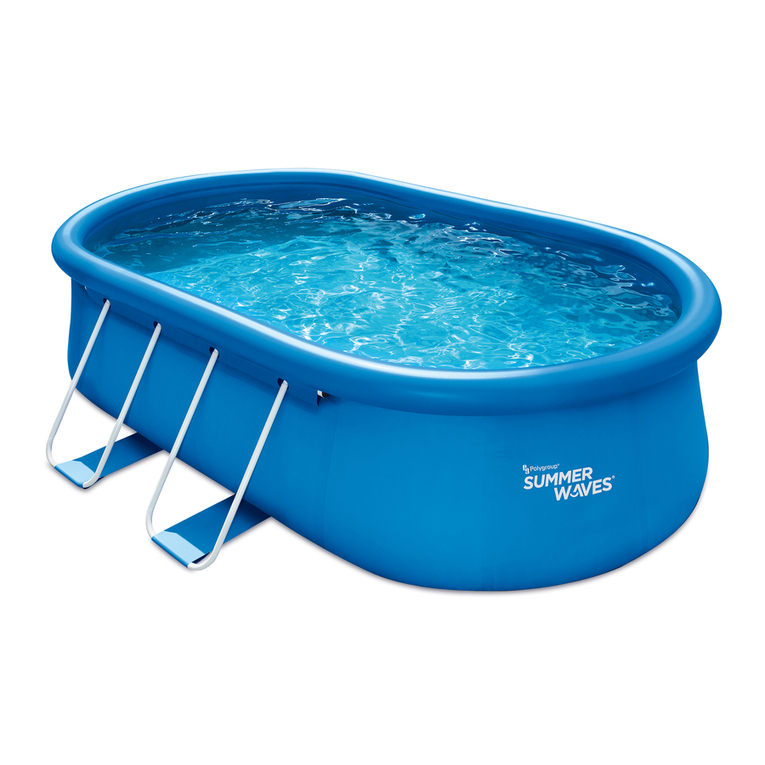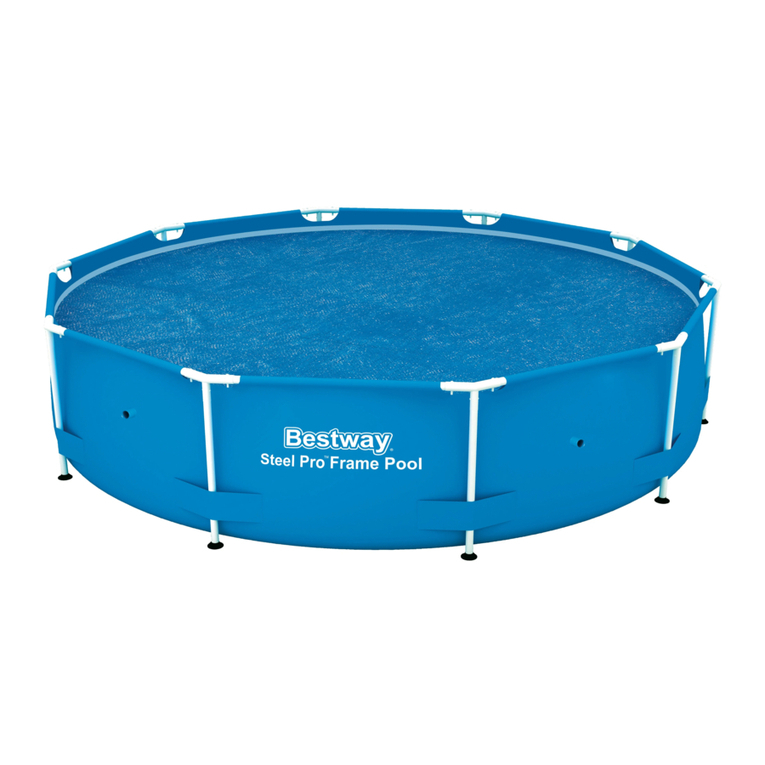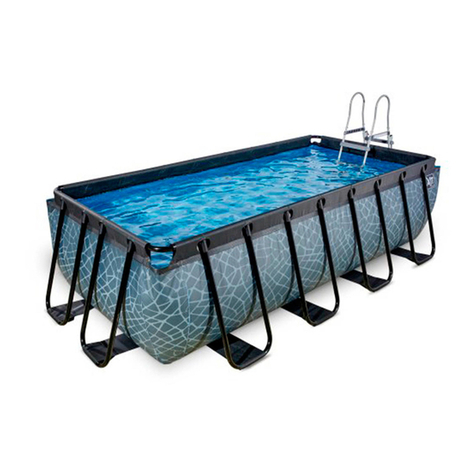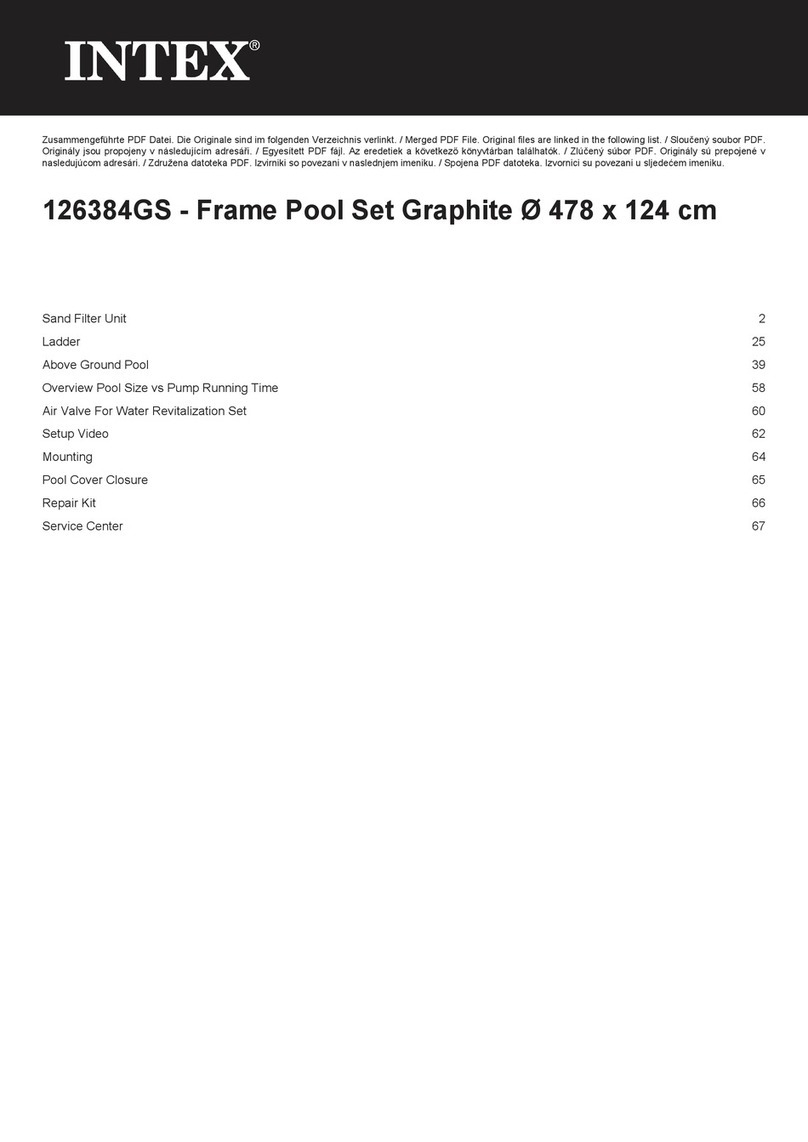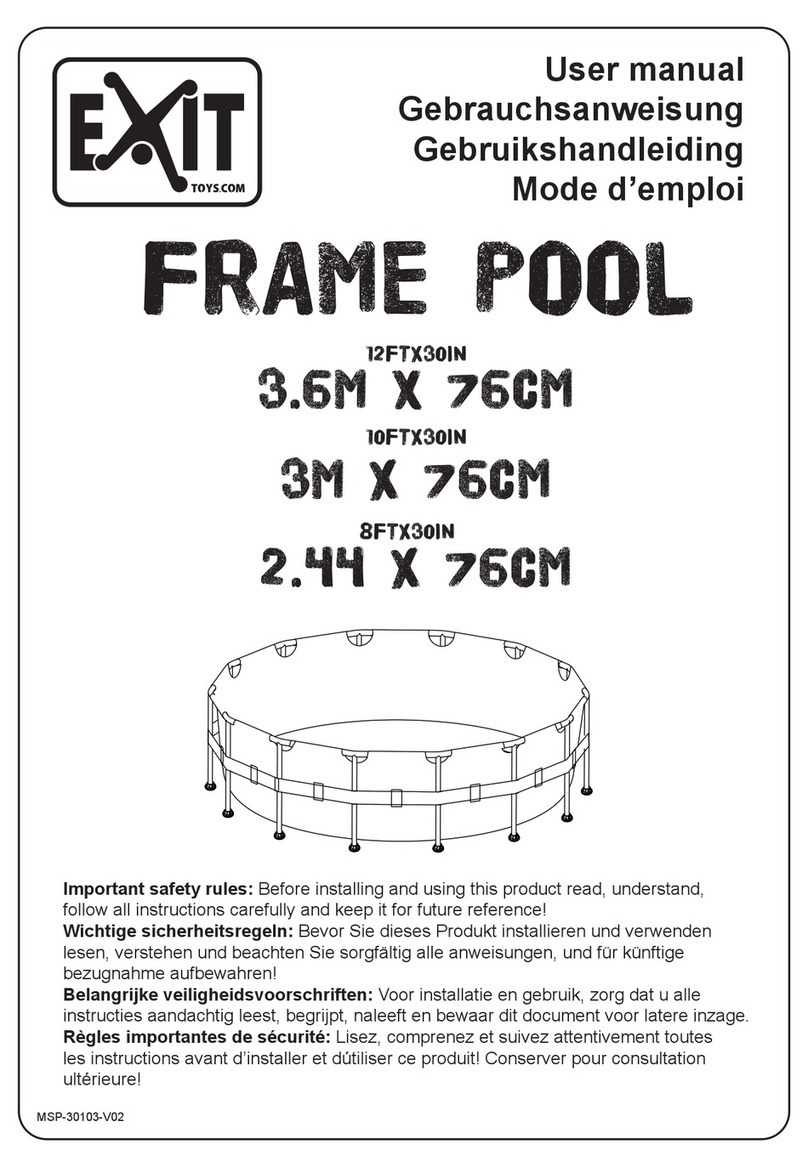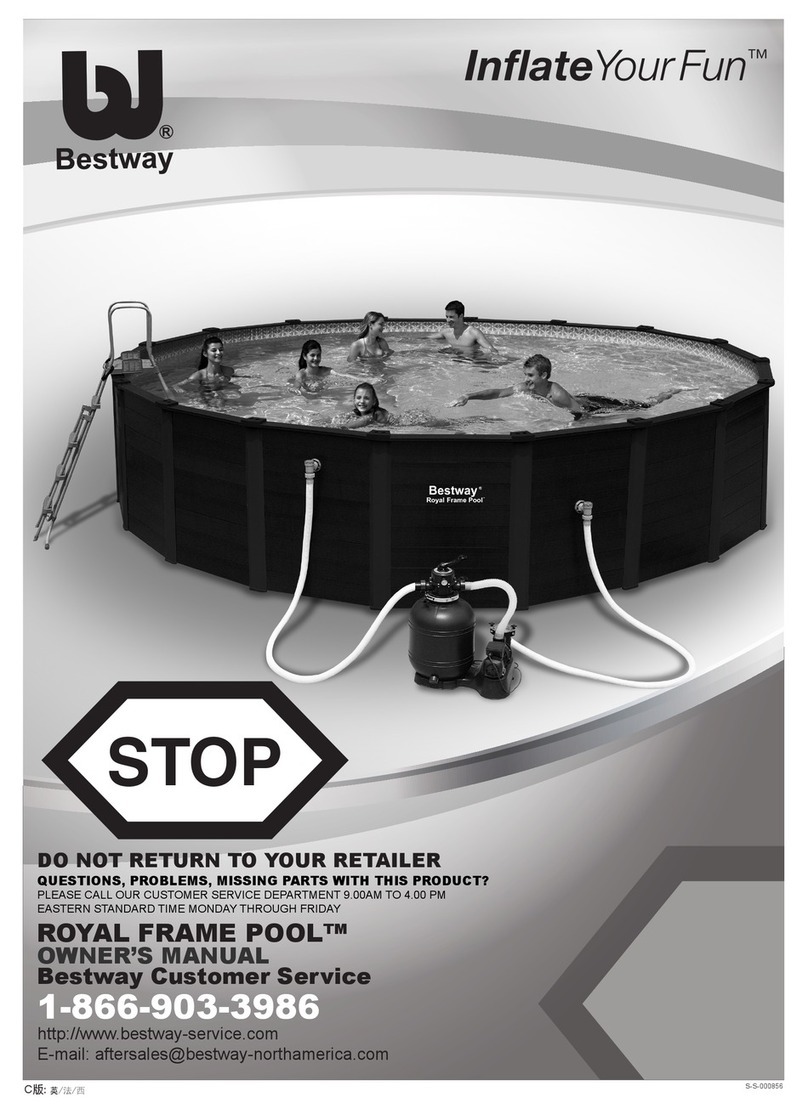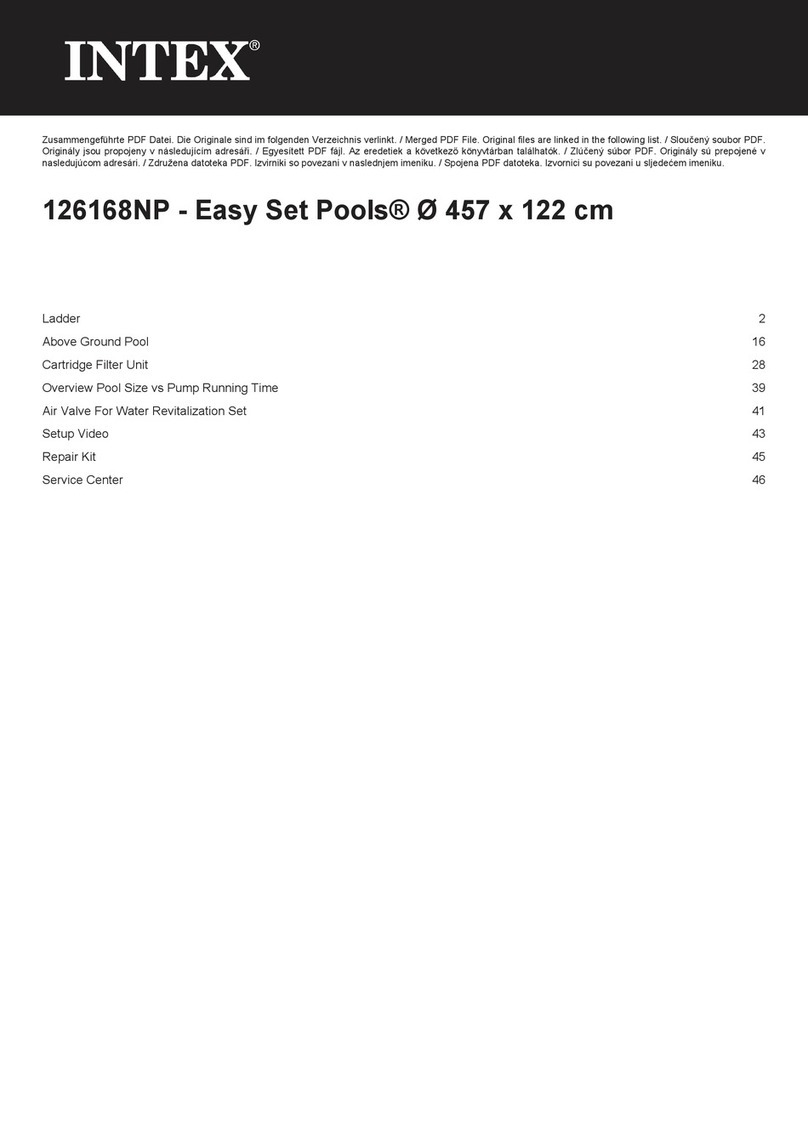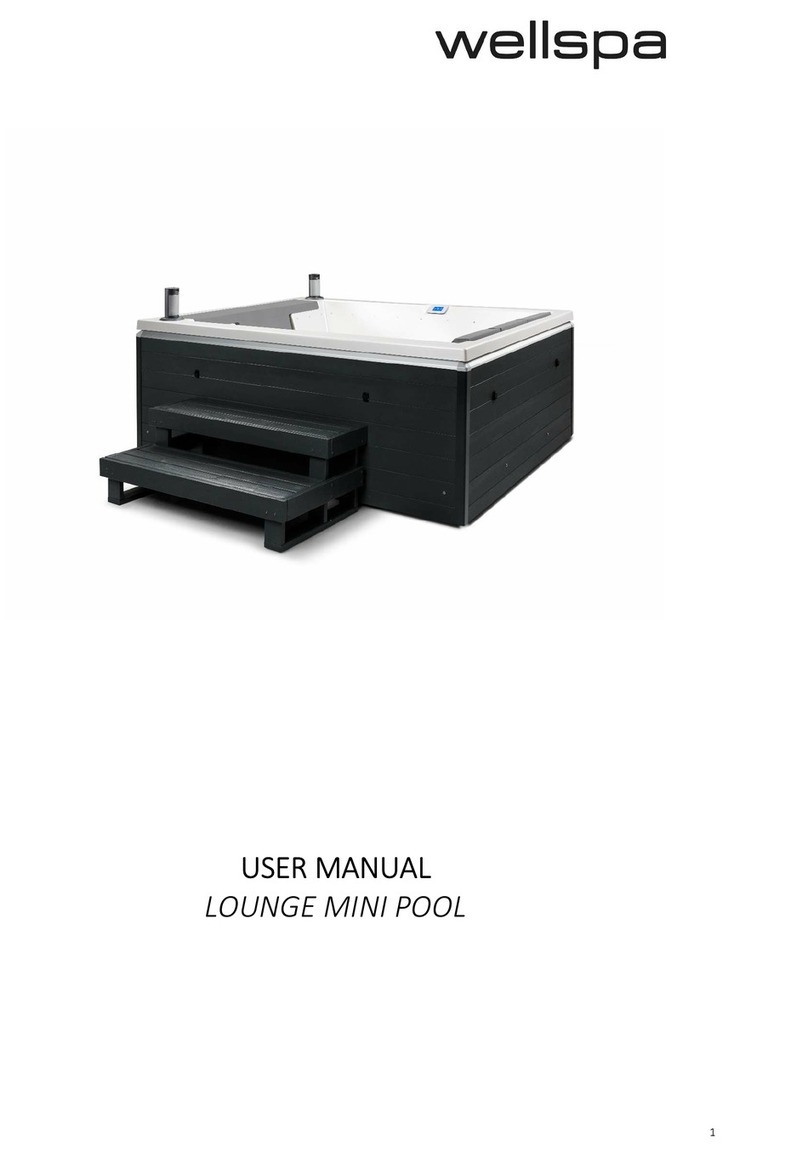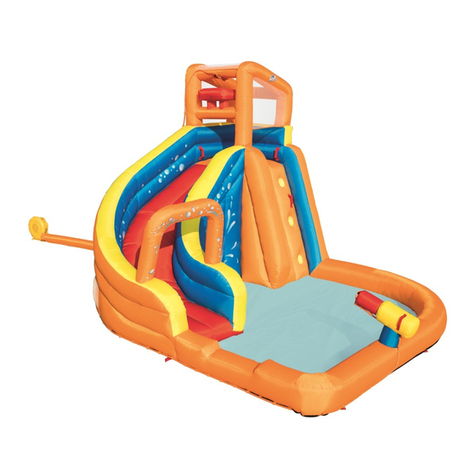
3
WICHTIGER HINWEIS: 220 V-Gerate müssen
mindestens 3,50 m von Schwimmbadrand entfernt
liegen.
Das Gerät muss an einen wechselstromanschluß mit
Erdung angeschlossen werden. Dieser muss durch ein
Differential (RCD) mit höchstens 30 mA gesichert sein.
Anleitung sorgfältig lesen und für spätere Zwecke
aufbewahren.
BEI PROBLEMEN KÖNNEN SIE SICH MIT
UNS UNTER DER FOLGENDEN DEUTSCHEN
TELEFONNUMMER IN VERBINDUNG SETZEN:
Germany & Austria
Freie nummer: 0 800-952 49 72
ATTENZIONE:Ogni apparecchio alimentato a
220 V, deve essere situato ad almeno 3,50 m
dal bordo della piscina.
L’attrezzatura va collegata ad una presa di
tensione di corrente alterna, con una
connessione a terra, protetta con un interruttore
differenziali (RCD) con una corrente di
funzionamento residuale assegnata che non
ecceda i 30 mA.
Leggere le istruzioni attentamente e conservarle
quale futuro riferimento.
BELANGRIJK:Alle apparaten die gevoed worden
met 220 V, dienen zich op z'n minst op een afstand
van 3,50 meter van de rand het zwembad te
bevinden.
Het toestel moet aangesloten op een geaard
netwerk met een wisselstroomspanning van 230
V en 50 HZ, en moet beschermd zijn door een
differentieelschakelaar (RCD) met eenresiduele
differentieelstroom van niet meer dan 30 mA.
Lees de gebruiksaanwijzing aandachtig en bewaar
die voor toekomstige raadplegingen.
MOCHT U EEN PROBLEEM HEBBEN...
¡RAADPLEEG ONS!
TELEFOONNUMMER VOOR ADVIES:
Nederlands & Belgïe
Tel.:+ 31 513 62 66 66
e-mai
web: www.gre.es
ATENÇÃO:Qualquer aparelho eléctrico
alimentado com 220 V, deve estra situado pelo
menos a 3,50 m do borde da piscina.
O aparelho deve ser ligado a uma tomada de
corrente alterna, com ligação à terra, protegida
com um interruptor diferencial (RCD) com uma
corrente de funcionamento residual que não
exceda os 30 mA.
Leia atentamente estas instruções, e guarde-
as para futuras consultas.
EM CASO DE PROBLEMA...¡CONSULTAR-NOS!
TELÉFONO CONSULTA:
web: www.gre.es
Vor Einbau und Nutzung des Pools bitte aufmerksam die in
diesem Handbuch aufgeführten Informationen lesen,
verinnerlichen und einhalten. Die Sicherheitshinweise und
-vorschriften beziehen sich auf einige der am häufigsten
auftretenden Risiken in Zusammenhang mit Freizeit im
Wasser, sie umfassen jedoch nicht alle Risiken und
Gefahren, die auftreten können. Seien Sie vorsichtig,
handeln Sie kritisch und mit gesundem Menschenvers-
tand, wenn Sie sich im Wasser aufhalten. Bewahren Sie
diese Informationen gut auf, um später darauf
zurückgreifen zu können.
Die Sicherheit der Menschen, die nicht schwimmen
können:
Eine aufmerksame, aktive und kontinuierliche
Überwachung der Kinder, die nicht oder noch nicht gut
schwimmen können durch einen dafür zuständigen
Erwachsenen ist stets erforderlich (bitte bedenken Sie,
dass bei Kindern unter fünf Jahren das höchste Risiko zu
ertrinken auftritt).
− Sorgen Sie dafür, dass ein dafür zuständiger
Erwachsener den Pool stets überwacht, wenn dieser
genutzt wird.
− Zweckmäßig ist, dass Kinder, die nicht oder noch nicht
gut schwimmen können, bei der Benutzung des Pools eine
eigene Schutzausrüstung tragen.
− Wenn der Pool nicht genutzt oder nicht überwacht wird,
entfernen Sie alle Spielsachen daraus, um zu verhindern,
dass sich die Kinder dem Pool nähern.
Sicherheitsvorrichtungen
− Es ist empfehlenswert, eine Sperre anzubringen (und in
diesem Fall Sicherheitselemente an Türen und Fenstern
anzubringen), um einen etwaigen nicht erlaubten Zugang
zum Pool zu verhindern.
− Sperren, Abdeckungen, Alarme für Pools oder analoge
Sicherheitsvorrichtungen sind hilfreich, ersetzen jedoch
nicht die ununterbrochene Überwachung durch einen dafür
zuständigen Erwachsenen.
Sicherheitsausrüstung
− Es wird empfohlen, eine Rettungsausrüstung
(beispielsweise eine Boje) nahe dem Pool zur Hand zu
haben.
− Halten Sie am Pool ein einwandfrei funktionierendes
Telefon und eine Liste mit den Notrufnummern bereit.
Sichere Nutzung des Pools
− Regen Sie alle Benutzer, vor allem Kinder, dazu an,
schwimmen zu lernen.
− Erlernen Sie Rettungsmethoden (Herz-Lungen-Wieder-
belebung) und bringen Sie Ihre Kenntnisse regelmäßig auf
den neuesten Stand. Diese Handgriffe können im Notfall
Leben retten.
− Erklären Sie den Nutzern des Pools, auch den Kindern,
welche Vorgehensweise diese im Notfall zu befolgen
haben.
− Springen Sie nie in flache Becken, da Sie dabei ernste
oder sogar tödliche Verletzungen erleiden können.
− Nutzen Sie den Pool nicht nach dem Konsum von
Alkohol oder der Einnahme von Medikamenten, bei denen
die Gefahr besteht, dass Sie den Pool nicht in absoluter
Sicherheit nutzen können.
− Ist der Pool mit einer Abdeckung bedeckt, entfernen Sie
diese vor Betreten des Beckens vollständig.
− Bereiten Sie das Wasser Ihres Pools auf und legen Sie
anerkannte Hygienemaßnahmen fest, um die Nutzer vor
wasserbedingten Krankheiten zu schützen. Bitte
entnehmen Sie dem Handbuch, wie man das Wasser
richtig aufbereitet.
− Bewahren Sie chemische Produkte (beispielsweise
Produkte zur Wasseraufbereitung, Reinigung oder
Desinfektion) außerhalb der Reichweite von Kindern auf.
− Die beiliegenden Piktogramme müssen an einer gut
sichtbaren Stelle weniger als 2 Meter vom Pool entfernt
angebracht werden.
− Befestigen Sie die bewegliche Treppe an einer
horizontalen Oberfläche.
SICHERHEITSHINWEISE. Prima di installare e utilizzare la piscina si prega di
leggere attentamente le informazioni contenute in
questo manuale, avendo cura di comprenderle e
rispettarle. Gli avvisi, le istruzioni e le indicazioni
sulla sicurezza si riferiscono ad alcuni dei rischi
più comuni relativi all'utilizzo della piscina, ma non
coprono la totalità dei rischi e dei pericoli che
possono verificarsi. Occorre essere prudenti,
avere senso critico e comune buonsenso nella
pratica delle attività acquatiche. Conservare
queste informazioni per successive consultazioni.
Precauzioni di sicurezza per le persone che
non sanno nuotare:
È necessario mantenere una vigilanza attenta,
attiva e continuativa da parte di un adulto
responsabile dei bambini che non sanno nuotare o
non lo sanno fare bene (occorre tenere presente
che sono maggiormente a rischio di annegamento
i bambini di età inferiore ai 5 anni).
- Garantire la vigilanza da parte di un adulto
responsabile ogniqualvolta si utilizza la piscina.
- È auspicabile che i bambini che non sanno
nuotare o non nuotano bene utilizzino dei
dispositivi di protezione individuale quando
entrano in piscina.
- Quando la piscina non viene utilizzata o non è
sorvegliata, rimuovere tutti i giocattoli per evitare
che i bambini si avvicinino incautamente.
Sistemi di sicurezza
- Si consiglia di installare una barriera (e, se
necessario, elementi di sicurezza sulle porte e
sulle finestre dell'abitazione) per impedire
qualsiasi accesso non autorizzato alla piscina.
- Le barriere, le coperture, gli allarmi per piscine o
i dispositivi di sicurezza analoghi sono utili, ma
non sostituiscono la vigilanza permanente da
parte di un adulto responsabile.
Dispositivi di sicurezza
- Si raccomanda l'utilizzo di dispositivi di
salvataggio (ad esempio un salvagente) vicino alla
piscina.
- Disporre, nei pressi della piscina, di un telefono
perfettamente funzionante e di un elenco dei
numeri di emergenza.
Utilizzo sicuro della piscina
- Incoraggiare tutti gli utilizzatori, soprattutto i
bambini, a imparare a nuotare.
- Imparare le tecniche di salvataggio (rianimazione
cardiopolmonare) e aggiornare periodicamente le
proprie conoscenze. Questi gesti, in caso di
emergenza, possono salvare una vita.
- Spiegare agli utilizzatori della piscina, anche ai
bambini, la procedura da seguire in caso di
emergenza.
- Non tuffarsi mai in piscine poco profonde, in
quanto ciò può provocare lesioni gravi o mortali.
- Non utilizzare la piscina dopo aver assunto alcol
o farmaci che possono ridurre la capacità di farlo
in tutta sicurezza.
- Se la piscina è dotata di una copertura,
rimuovere completamente l'acqua presente sulla
superficie prima di entrare.
- Trattare l'acqua della piscina e impostare
pratiche di igiene corrette per proteggere gli
utilizzatori da malattie legate all'acqua. Consultare
le informazioni sul trattamento dell'acqua presenti
nel manuale di istruzioni.
- Tenere lontano dalla portata dei bambini i
prodotti chimici (ad esempio i prodotti per il
trattamento dell'acqua, la pulizia e la disinfezione).
- È necessario posizionare i dispositivi di
segnalazione forniti insieme alla piscina in
posizione ben visibile, a meno di 2 m di distanza
dalla piscina.
- Posizionare le scalette mobili su una superficie
orizzontale.
INFORMAZIONI SULLA
SICUREZZA. Voor het installeren en in gebruik nemen van het
zwembad, dient u de informatie die in deze handleiding
is vervat aandachtig door te lezen, goed in u op te
nemen en na te leven. De mededelingen, instructies en
de aanbevelingen betreffende de veiligheid hebben
betrekking op enkele van de meest voorkomende
risico’s die bestaan bij vrijetijdsbesteding in het water;
deze beslaan echter niet alle risico’s en gevaren die
zich zouden kunnen voordoen. Wees voorzichtig en
kritisch, en gebruik vooral uw gezonde verstand bij het
beoefenen van activiteiten in het water. Bewaar deze
informatie zodat u alles op een later moment nog eens
kunt nalezen.
Veiligheid van personen die niet kunnen zwemmen:
Er moet altijd een verantwoordelijke volwassene
aanwezig zijn die alert, actief en voortdurend toezicht
houdt, met name op kinderen die niet kunnen zwemmen
of die dat nog niet goed kunnen (houd er rekening mee
dat het risico op verdrinking het hoogst is onder
kinderen jonger dan vijf jaar).
− Zorg ervoor dat er steeds een verantwoordelijke
volwassene aanwezig is die toezicht houdt op het
zwembad, iedere keer dat het wordt gebruikt.
− Het is wenselijk dat kinderen die niet kunnen
zwemmen of die dat nog niet goed kunnen beschikken
over persoonlijke beschermingsmiddelen wanneer ze
gebruikmaken van het zwembad.
− Wanneer het zwembad niet wordt gebruikt of wanneer
er geen toezicht aanwezig is, alle speelgoed eruit halen
om te voorkomen dat kinderen zich in de buurt ervan
begeven.
Veiligheidsvoorzieningen
− Het is aanbevolen om een barrière te installeren (En,
indien nodig, veiligheidselementen te installeren in
deuren en ramen) om onbevoegde toegang tot het
zwembad te voorkomen.
− Barrières, afdekzeilen, zwembadalarmen of
vergelijkbare veiligheidsvoorzieningen zijn nuttig, maar
vormen géén vervanging voor de voordurende controle
door een verantwoordelijke volwassene.
Veiligheidsvoorzieningen
− Het is aanbevolen om reddingsmateriaal
(bijvoorbeeld, een reddingsboei) paraat te hebben
vlakbij het zwembad.
− Zorg ervoor dat er een goed werkende telefoon en
een lijst met telefoonnummers van hulpdiensten
voorhanden zijn in de buurt van het zwembad.
Veilig gebruik van het zwembad
− Moedig alle gebruikers aan, vooral kinderen, om
zwemles te nemen.
− Leer reddingstechnieken (m.n. cardiopulmonaire
reanimatie) en werk uw kennis regelmatig bij. Deze
technieken kunnen een leven redden in geval van nood.
− Leg aan alle gebruikers van het zwembad uit, óók aan
kinderen, welke procedures ze moeten volgen in
noodgevallen.
− Duik nooit in een ondiep zwembad daar dit ernstig of
dodelijk letsel tot gevolg kan hebben.
− Maak geen gebruik van het zwembad nadat u alcohol,
drugs of medicijnen heeft gebruikt die uw vermogen of
bewustzijn beïnvloeden om dat in een geheel veilige
toestand te kunnen doen.
− Indien het zwembad is afgedekt door afdekzeil, dient
u het volledig van het wateroppervlak weg te halen
alvorens het bad te betreden.
− Behandel het water van uw zwembaden en houd er
goede hygiënische praktijken op na om gebruikers
tegen watergerelateerde ziekten beschermen. Kijk na
hoe u het water moet behandelen in de gebruiksaanwi-
jzing.
− Houd chemische producten (bijvoorbeeld: producten
voor waterbehandeling, voor schoonmaak of om te
desinfecteren) buiten het bereik van kinderen.
− Het is verplicht om de bijgeleverde pictogrammen op
een zichtbare plek op minder dan 2 meter van het
zwembad te plaatsen.
− Plaats de verplaatsbare trappen op een horizontaal
terrein.
Antes de instalar e de utilizar a piscina, leia
atentamente a informação incluída neste manual,
assimile-a e cumpra-a. Os anúncios, as
instruções e as ordens de segurança dizem
respeito a alguns dos riscos mais habituais
relativos ao lazer na água, mas não cobrem a
totalidade dos riscos e perigos que podem surgir.
Seja prudente e tenha senso crítico e senso
comum quando praticar atividades aquáticas.
Guarde esta informação para ulteriores
consultas.
Segurança de quem não sabem nadar:
Sempre é necessária a vigilância atenta, ativa e
contínua por parte de um adulto responsável
sobre as crianças que não sabem nadar ou que
não o fazem bem (tenha em conta que o risco de
afogamento mais elevado é o que atinge as
crianças de menos de cinco anos).
− Tente que um adulto responsável vigile a
piscina sempre que é utilizada.
− É conveniente que as crianças que não sabem
nadar ou que não o fazem bem contem com
equipamentos de proteção individual quando
utilizem a piscina.
− Quando a piscina não seja utilizada ou se
encontre sem vigilância, deve retirar todos os
brinquedos dela a fim de evitar que as crianças
se aproximem dela.
Dispositivos de segurança
− É recomendável instalar uma barreira (e, se for
caso disso, instalar elementos de segurança em
portas e janelas) a fim de evitar qualquer acesso
não autorizado à piscina.
− As barreiras, as coberturas, os alarmes para
piscinas ou os dispositivos de segurança
análogos, são úteis, mas não substituem a
vigilância contínua por parte de um adulto
responsável.
Equipamento de segurança
− É recomendado dispor de material de
salvamento (uma boia, por exemplo) perto da
piscina.
− Tenha um telefone em perfeito estado e uma
listagem de números de emergências perto da
piscina.
Uso seguro da piscina
− Encoraje todos os usuários, especialmente as
crianças, a aprender a nadar.
− Aprenda técnicas de salvamento (reanimação
cardiopulmonar) e atualize periodicamente os
seus conhecimentos. Isto pode salvar uma vida
numa emergência.
− Explique aos usuários da piscina – também às
crianças – o procedimento que devem seguir em
caso de urgência.
− Nunca mergulhe em piscinas pouco profundas,
dado que pode sofrer lesões graves ou mortais.
− Não utilize a piscina após ter ingerido álcool ou
medicamentos suscetíveis de reduzir a sua
capacidade de o fazer em condições de
segurança total.
− Se a piscina estiver tapada por uma cobertura,
deverá retirá-la completamente da superfície da
água antes de entrar.
− Trate a água da sua piscina e estabeleça boas
práticas de higiene para proteger os usuários de
doenças relacionadas com a água. Consulte
como tratar a água no manual de instruções.
− Mantenha fora do alcance das crianças os
produtos químicos (produtos de tratamento da
água, de limpeza ou de desinfeção, por
exemplo).
− É obrigatório colocar os pictogramas incluídos
numa posição visível a menos de 2 m da piscina.
− Coloque as escadas móveis sobre uma
superfície horizontal.
VEILIGHEIDSINFORMATIE INFORMAÇÃO DE
SEGURANÇA
SERVIZIO TECNICO IN ITALIA:
link web >inizio > servizi > servizi tecnico > italia
web: www.gre.es
SERVIÇOS TECNICO EM PORTUGAL:
link web > inicio > serviço > serviço técnico > portugal
web: www.gre.es
PER OGNI VOSTRA EVENTUALE OCCORRENZA,...
INTERPELLA-TECI! Italia Tel.: 800 781 592
